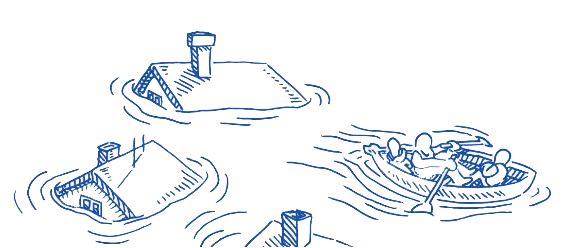From flood protection to bushfire mitigation strategies, building resilient infrastructure is more vital than ever – and local experts are calling for urgent investment to aid future disaster recovery.
If the climate alarm was not ringing before now, in recent years it has been sounding virtually non-stop.
Last summer, Australia was subject to devastating bush fires, unprecedented in their scope and intensity.

in Blue Mountains, Australia
The biggest fires created their own weather patterns, setting spot fires hundreds and sometimes thousands of metres ahead of the main fire front. In a bone-dry environment that hadn’t seen any significant rain for seven years in certain areas, those spot fires quickly developed into major burns. In the words of Lee Johnson, who spent over a decade in charge of Queensland’s fire service, these fires were “… like nothing we’ve ever seen before”.
To compound the disaster, a few weeks after fires swept through Australian towns, some of these same settlements were flooded when rainwater from heavy storms was unable to be absorbed by the scorched earth.
On the other side of the Tasman, it was flooding that overwhelmed the New Zealand town of Edgecumbe in 2017, when torrential rain burst the banks of the Rangitaiki River, inundating the North Island east-coast community with water and causing untold damage.

In New Zealand, flooding is an ever-present risk. But, says Dave Cull, former President of Local Government New Zealand (LGNZ), even where flood mitigation infrastructure has been put in place, the changing climate is creating different types of floods with different types of water flows, as was seen at Edgecumbe.
So, in light of these disastrous events and numerous others in recent years, how can we enhance disaster management through infrastructure resilience as weather events continue to get ever-more extreme?
Building environmental resilience
Unlike their local government neighbours in the Adelaide Hills and on Kangaroo Island, the inner-Adelaide council of the City of Prospect didn’t face any direct fire threat last summer. But they did suffer a very hot spell, with four days over 40 degrees, during which they had to enact their Cool Relief Strategy. This involved staying in touch with the vulnerable in the community via organisations such as Red Cross.
Mayor David O’Loughlin, who is also President of the Australian Local Government Association (ALGA), believes the future big issues for his council are around environmental resilience.

“We’re pushing very hard to get recycled plastics and recycled tyres into our pavement services, and recycled glass into our road bases,” says O’Loughlin. “We’re doing it to make sure we’re approaching resilience from a whole-lifecycle approach, and to minimise the demand on extraction of natural resources by reusing materials as often as is practicable.”
The council is also working to reduce the ‘urban heat island’ effect – characterised by an urban area measuring several degrees hotter than its surrounding green areas – by adopting a ‘green-tunnel strategy’. This will mean every road is covered by a canopy of trees, shading normally exposed surfaces such as roads, footpaths and parked cars.
Across Australia, says O’Loughlin, councils in different regions are facing their own distinctive challenges, and he believes success in planning for a resilient infrastructure environment comes from a recognition of this uniqueness.
A case in point is the development of critical infrastructure in the Northern Territory where weather patterns differ markedly from the south – a fact often ignored at the planning stage, according to Chris Francis, CEO of Laynhapuy Homelands Aboriginal Corporation, or Laynha.
He cites the proposed upgrade of the Central Arnhem Road, from Katherine to Nhulunbuy, which has been allocated $225 million by the Australian and Northern Territory Governments for the reconstruction, widening, sealing and flood-proofing of parts of the route.
“There should be three to four times that much invested,” he says.
“The cost per kilometre is going to be different than it would be if you were doing it in Sydney. Public works in this region are more costly and more difficult, and government is simply not attuned to that because they work on an east-coast, urban model.”

Francis has seen the problems with the changing weather first-hand. Based in Yirrkala, a coastal town in a remote area of the NT, Laynha services an area of more than 18,000 square kilometres. Weather can be the difference between making it home safely and being flood-bound, stranded and at risk.
“We’re seeing changes over a period of time with respect to patterns of weather, not just intensity. If you look at predictability in climate in other places around the world, ours is far more unpredictable,” he says.

That volatility makes planning infrastructure more challenging.
“In the north, we basically have wet and dry seasons,” says Francis. “In most of Australia, infrastructure projects are 24/7 work throughout the year. That’s not how it works in northern Australia. Our planning is different and our delivery is different. If there are changes to the climate in duration of periods of wet and dry, or in intensity, that can make the work of engineers and planners far more complex.”
Developing community understanding
As rising sea levels combined with surging groundwater levels present a resilience challenge in New Zealand’s coastal towns, community engagement becomes ever-more vital.
“Over the last several years we put a lot of effort into engaging with people, particularly those in the area of Dunedin that was flooded in 2015,” explains Cull. “During and after the floods there was a lot of animosity directed at Council, believing they had been caused by a lack of maintenance of the drains.

“We needed to find out what the community wanted us to do, but first the community had to know exactly what was going on and also know all of the potential options. We needed to build a shared understanding, get various stakeholder groups together and build community consensus, because there are always choices.”
O’Loughlin agrees, believing the experience of last summer has guaranteed the engagement of the community in Australian towns and cities.

“The community doesn’t need any more lectures about climate change,” he says. “They want to see action and they are disappointed when governments don’t step up and take action.”
Many of the bushfire mitigation strategies and infrastructure resilience projects are needed in local council areas that simply can’t afford them. So, the ALGA has requested extra disaster mitigation funding from the Federal Government to cover major risk across Australia.
“The Productivity Commission conducted a study a few years ago and indicated that it was of net benefit to the nation to invest in disaster mitigation,” says O’Loughlin.
“They estimated the cost was approximately $200 million a year for five years. We agree with the calculations and we have used those in our advocacy. It’s government that now needs to be convinced of the value of such an investment.
Spend now to avoid disaster later
“The amount of anger I’ve seen in the community about the government’s response to the number and intensity of fires has been palpable. They expect governments to do more to protect them, not just during the disaster but also from disasters. So the community is on board in expectation and in spirit. Their expectations have never been higher to see government mitigate the causes and protect them from the risks.”
Funding disaster mitigation strategies
In the 2020/21 Pre-Budget Submission from the Australian Local Government Association (ALGA) to the Treasurer, a new budget of $200 million per year for the next four years was proposed. Its intention is to fund a targeted disaster mitigation project by local governments across the nation.

In the Productivity Commission’s report, ‘Stronger Safer Together’, it says: “Deloitte Access Economics in a report commissioned by the Australian Business Roundtable for Disaster Resilience & Safer Communities, has averaged $18.2 billion per year, equivalent to 1.2% of average gross domestic product (GDP) over the same period. This is expected to reach $39 billion per year on average by 2050 (in present value terms), even without considering the impact of climate change.” The first report from the Australian Business Roundtable for Disaster Resilience & Safer Communities, in 2013, revealed that annual Australian Government expenditure on pre-disaster resilience of $250 million nationally “has the potential to generate budget savings of $12.2 billion for all levels of government (including $9.8 billion for the Australian Government) and would reduce natural disaster costs by more than 50% by 2050,” the ALGA report adds. Proof, if proof were needed, that while the alarm bells continue to ring ever-louder, this is a cost that needs to be met.














